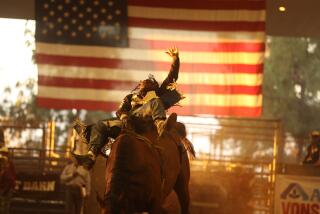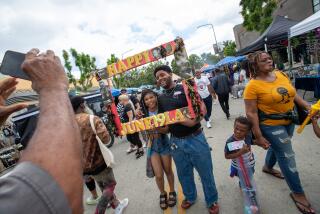Season of Pride : Blacks Celebrate Heritage in Weeklong Kwanzaa Festival
- Share via
Bargain-hunters flocking to day-after-Christmas sales were not the reason that a corner of the Baldwin Hills Crenshaw Plaza shopping center was jammed Thursday.
The throng near the entrance to the Broadway department store was celebrating the start of Kwanzaa--an African-themed harvest festival.
The 25-year-old observance is the newest of the end-of-the-year celebrations traditionally held in December. But blacks say it honors one of the world’s oldest civilizations--theirs.
“It’s a very important time of the year for all of us to come together and celebrate who we are,” state Sen. Diane Watson (D-Los Angeles) told a crowd of about 200 that gathered for speeches, dancing and the lighting of a candle to mark the start of the seven-day event.
“We can afford to say we are black and full of pride. Don’t forget you have a past,” Watson said. “You are the descendants of kings and queens.”
To drive home the point, local Kwanzaa organizers picked their own king and queen to reign over this year’s event, which includes a three-day festival that starts today at Leimert Park and a Crenshaw Boulevard parade scheduled to travel between Adams Boulevard and the park Saturday starting at 11 a.m.
Kenneth R. Thomas, board chairman of the Los Angeles Sentinel newspaper, and Ahneva Ahneva, a fashion designer, were named Thursday to the honorary positions; they will preside over activities through Jan. 1.
The king and queen titles, like most other aspects of Kwanzaa, carry Swahili names. Thomas is oba . Ahneva is iyaba .
Melva Parhams, one of the organizers of the parade, lit the first candle. She explained to the mall crowd that the candles are called mishumma saba and represent the seven principles of Kwanzaa. They are unity, self-determination, collective work and responsibility, cooperative economics, purpose, creativity and faith.
Living lives based on those principles “can change the community,” said Sala Shabazz-Bey, who credits them for “making me able to build a business at a time when jobs are few and far between.”
Shabazz-Bey has published a booklet that explains such things as how red, black and green colors play a role in Kwanzaa. It also offers suggestions of how the holiday can be observed through the exchange of gifts that reflect African cultural heritage as envisioned by black activist Ron Karenga, who created Kwanzaa in 1966. He is now known as Maulana Karenga.
Thursday’s ceremonies, which were staged in front of former basketball star Magic Johnson’s mall sports shop, included a discussion of AIDS and the circulation of petitions calling for the name of the Leimert Park area to be changed to the “International African Village District.”
Onlooker Effena Jackson, 12, watched wide-eyed as costumed dancers performed African-style movements to the rapid-fire beat of drums. She said she would like to see her family celebrate Kwanzaa, provided “we can be sure the candles are safe.”
Her mother, Helene Jackson, said she is willing to give Kwanzaa a try.
“It wouldn’t replace Christmas,” Jackson said. “But it’s a good opportunity to teach our children where they came from.”
Jackson purchased one of Shabazz-Bey’s books for guidance.
“This is new to us,” she said. “We’re learning.”
More to Read
Sign up for The Wild
We’ll help you find the best places to hike, bike and run, as well as the perfect silent spots for meditation and yoga.
You may occasionally receive promotional content from the Los Angeles Times.







